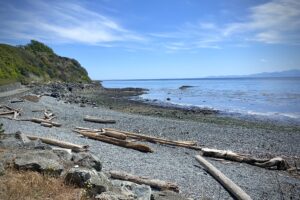

Learning Objectives
Upon careful examination and reflection on the blog post, it is anticipated that readers would:
- Acquire a foundational understanding of the historical context surrounding the plague;
- Recognise the various forms of the plague and the modes of transmission;
- Discern the symptoms associated with the plague;
- Have a practical comprehension of the risk factors linked to the plague and strategies to reduce them; and;
- Understand the general regulatory measures that have been implemented to curtail the spread of the plague.
Topics Covered
This post discusses the context of the plague, including:
- Its potential locations;
- Classification into sub-groups;
- Associated symptoms;
- Mortality rates;
- Modes of transmission;
- Strategies for infection control;
- Regulatory measures implemented to reduce diseases occurrences; and,
- Beacon Hill, located on Vancouver Island in British Columbia where the plague may have been present thousands of years ago.

There is evidence suggesting that the plague may have once been present at Beacon Hill (British Columbia Geographical Names Office, n.d.). The Plague: A Pandemic from the Roman Era to the Present Day
This is expected to result in a significant increase in cases of people exposed to an infectious disease, such as the plague. Moreover, a pandemic often affects multiple countries over a prolonged duration (Columbia University Mailman School of Public Health, 2021). Also, public health and healthcare systems have struggled to respond to (COVID-19) Novel Coronavirus and previous pandemics, e.g. the Spanish Flu’s and the plague’s extent and ramifications. Notably, COVID-19 was not previously recognised in humans, and its health effects can range from none to mild symptoms. Generally, while many individuals recover from the effects of COVID-19, it is unfortunate that some may require hospitalisation, and those who suffer severe infections could succumb to the illness. Subsequently, this adds to natural and human introduced disasters. Furthermore, your advance knowledge of the plague and other disasters can act as a crucial component in preparing for resilience and preventing calamities.
Read more about these in the Resiliency Toolkit.
The Context of the Plague
The context in which quarantine regulations are applied to limit disease includes physical distancing, self-isolation, and closure of public spaces such as national, state and provincial parks is complex. Moreover, it is essential to understand the legal context and responses to the plague (Owens & Riley, 2007). Potentially the plague continues to be present in Canada and beyond.
Where is the Plague Present?
The plague is mostly present in central and southern Africa, particularly the eastern Democratic Republic of the Congo, the north west parts of Uganda, Madagascar; the south west of Ame; the north east of South America; central Asia; and the Indian subcontinent (The United States Centers For Disease Control and Prevention, 2023; 2024a).

Reported Plague Cases in the United States
The United States Centers For Disease Control and Prevention (2024a) estimated that there are seven reported cases of plague each year in America. Earlier, the first recorded instance of plague in the United States occurred in 1900. Notably, America where the disease have been reported were: “Northern New Mexico, northern Arizona, and southern Colorado; California, southern Oregon, and far western Nevada” (The United States Centers For Disease Control and Prevention, 2024a).
Above all, 80% of these cases have been bubonic. Moreover, the age categories have spanned from infancy to 96 years old. Basically, the plague remains present in various locations (Guzman, 2024). Furthermore, could it be that the true number of cases is not being accurately reported? Furthermore, is it possible that time and further inquiry will provide clarity on this matter?
The Plague and Sub-Groupings
This disease is categorised into three primary sub-groupings:
- bubonic;
- pneumonic; and,
- septicaemic (National Library of Medicine, 2011; United States Centers For Disease Control and Prevention, 2018).
The Plague and its Symptoms
Common symptoms associated with plague sub-groupings may range from fever to general weakness. Notably, the World Health Organization (2022) wrote about bubonic and pneumonic sub-groups. Another key point, the plague is attributable to the Yersinia pestis bacterium (National Library of Medicine, 2011; Public Health Agency of Canada, 2018a). Notably, this bacterium may have first emerged on the planet approximately 1,500 to 20,000 years ago.
Bubonic and Septicaemic Plague
The bubonic sub-group typically manifests in the lymph nodes, such as in the groin area. You may have an irritated throat, experience nausea and a headache. (Delaware Health and Social Services, n.d.). Eventually, About 30% to 60% of victims with bubonic plague may die (National Library of Medicine, 2011; World Health Organization, 2022). Notably, the septicaemic plague can lead to bleeding into the skin and organs, abdominal soreness, and shock. Above all, if you believe you have been exposed to infected sources, seek out medical assistance as soon as possible.
The COVID-19 virus can be transmitted through infected sources, such as, respiratory droplets from people within a two-meter, or just over a six feet radius, particularly when they cough, laugh, sneeze, or speak. Moreover, if you unintentionally touch your face, mouth, or eyes before you exercise proper hand hygiene. Additionally, some carriers of COVID-19 may be asymptomatic, thereby facilitating the spread of the virus.
The Period of Incubation
The incubation period for the septicaemic plague may be about one day to a week (Martin, 2024; World Health Organization, 2022). Notably, pneumonic plague could have an incubation period of between one to three days (Delaware Health and Social Services, n.d.; National Library of Medicine, 2011). Also, the incubation period for bubonic plague is about two to eight days. Furthermore, it is imperative that individuals infected with the bubonic form of the disease receive antibiotics within the first 24 hours, or as soon as feasible thereafter.
Seeking Out Urgent Medical AdviCe for Pneumonic Plague
People without medical advice and care could die, for example, from pneumonic plague. Another key point, pneumonic plague, can result in:
- respiratory challenges such as shortness of breath;
- the presence of infected mucus; and,
- coughing, chest and shock discomfort (Delaware Health and Social Services, n.d.).
Plague Fatalities
The plague has been the cause of significant pandemics that claimed the lives of millions of people (United States Centers for Disease Control and Prevention, 2024b; Randriantseheno et al., 2024). For example, during their brief occupation of Mesopotamia in southwestern Asia, the Roman Armed Forces encountered the Antonine Plague, which spread throughout the Roman Empire at that time (Lavan, 2024). Moreover, Glatter and Finkelman (2020) approximated that the death toll from the bubonic plague in the 14th Century reached 25 million people, which constituted approximately one-third of Europe’s population.
How is the Plague Spread?
The plague has been documented in regions including Africa, Asia, Europe, and South America (Public Health Agency of Canada, 2018a, The United States Centers for Disease Control and Prevention, 2024a).
Exposure to Fleas and Infected Animals
Fleas who live on rodents could mainly spread this disease when they bite their hosts (World Health Organization, 2022). For instance, cats, dogs, ground squirrels, and rats can be carriers (National Library of Medicine, 2011; Public Health Agency of Canada, 2018b). Moreover, you may contract the plague by coming into contact with infectious tissue or respiratory droplets.
Plague Transmission
The plague can be transmitted from animals to people and people to people (Keeling & Gilligan, 2000; Scutti & Hunt, 2024). Likewise, COVID-19, via direct physical contact, has transmitted from animals to humans and humans to humans.
What Can be Done to Limit Infection?
Outdoor activities whereby you are exposed to infected animals carrying fleas could elevate the risk of plague infection. Above all, fleas draw blood from both animal and human hosts, thereby exposing them to various bacterium, including those responsible for diseases such as the plague, bartonellosis, and rickettsiosis (Garcia-Sanchez, et al., 2024).
UtiliSing Antibiotics
You can mitigate the risk of plague exposure by utilising antibiotics when necessary. Furthermore, preventative strategies to control the spread of the plague involve reducing rodent habitats near residences, which includes organising firewood and properly disposing of accumulated waste (United States Centers For Disease Control and Prevention, 2024c).
The plague can be treated with antibiotics and for high-risk people the Yersinia pestis vaccine may be an option (Scutti & Hunt, 2024; Williamson & Oyster, 2013). Moreover, owners can help to protect their own and their pets’ interests by having them vaccinated (National Library of Medicine, 2011). To read more about vaccinations please see – Artificial Intelligence and Counselling.
Taking Precautions
It is advisable to wear gloves when handling infected animals (United States Centers For Disease Control and Prevention, 2024c). Additionally, you could consider employing flea control products for pets, restricting their access to endemic areas, and preventing them from sleeping on human beds.
So, remember to take precautions like using an insect repellent with DEET (United States Centres for Disease Control and Prevention, 2024c). Moreover, infected animals including your household pets, such as cats and dogs, contribute to an increased risk of infection (National Library of Medicine, 2011; Public Health Agency of Canada, 2018b). Above all, your pets and you could benefit from vaccinations and other preventative measures.

Quarantine Measures
Quarantine measures have had their own set of stresses as people face rapid change and segregation, which often undermines freedom of association (Borovoy, 1999). Furthermore, governments implement unpopular measures to control disease outbreaks, which could contribute to increased conflict and global instability. Additionally, borders have been closed, as seen in 2020 during the escalating COVID-19 pandemic (Airport Technology, 2000).
The 18th Century
Federal, state, and municipal governments aimed to safeguard peoples’ interests in the United States and their neighbours. However, gaps present that make it challenging to limit infectious conditions that give rise to the plague.
State and Municipal Governments, and Quarantine
The United States was formed on September 17, 1787 after what was a controversial process (United States Supreme Court Center, 2020). Notably, State governments selected their representatives to promote each States’ interests and together to form the Constitution. Moreover, Municipal governments were primarily responsible for maintaining and improving quarantine rules and practices.
State and Municipal governments made intermittent efforts to enforce quarantine laws. Eventually, with the outbreak of yellow fever the United States Federal government assumed a leadership role and upheld quarantine laws.
The 19th Century
Transportation systems in the 19th Century e.g. steam ships and trains brought travellers close together and made them vulnerable to cholera (Nagata, 2002). Moreover, in the 19th Century the American and Canadian federal governments needed to limit infectious conditions contributing to cholera outbreaks (Canadian Public Health Association, 2010).
David Dudley Field in 1876 provided an overview of quarantine (Diossy, 1872). Notably, governments design and enforce quarantine laws to safeguard public health by placing restrictions at seaports, ships and passengers to prevent conditions that contribute to pestilence. Generally, Field’s work categorised aspects of quarantine including the detention of ships and when they could travel. Lighthouse are familiar feature on Vancouver Island and they metaphorically represent beacons of hope and safety.

The 20th CENTURY
The United States experienced quarantine issues during the First World War. During the first six months of 1918, conditions were low, and war’s human costs were high (Shaw, 2014). Moreover, defence members and auxiliary staff were in crowded and unhygienic conditions at battlefronts. People had little immunity to the Spanish Flu that began varyingly in China, Europe, and the United States.

1918
During the first six months of 1918 conditions were poor and the human costs of war were high (Shaw, 2014). For example, a million people travelling between Europe and the United States were crowded together in ships and trains. Unfortunately, from September to December 1918, a more potent form of the Spanish Flu developed. Subsequently, this Flu was to have negative implications for one billion-plus people.
The Spanish Flu’s Casualties
The world experienced the flu’s devastating impact, and fifty million-plus people were estimated to have died. People’s life expectancy was reduced by ten years plus. People needed to be in isolation; some businesses ceased their operations. Public gatherings were restricted. The United States Public Health Service coordinated quarantine constraints and delegated authority to State and Municipal governments to regulate cinemas, pubs, schools and other places where people gathered. The Spanish Flu seemed to target youthful and healthy people.
What Could be Done?
In 1921 in the United States quarantine regulations were nationalised (Mayer, 2020). From 1944 onwards under The Public Health Services Act the United States government enforced quarantine laws.
The (COVID-19) pandemic ushered in an extraordinary period in human history characterised by numerous challenges in maritime shipping, particularly in securing suitable host seaports. Once infected ports were identified, adverse consequences have arisen, including criminal inquiries when passengers disembark from, actual or suspected, infected vessels (Vara, 2020). Furthermore, different states across the United States implemented varying quarantine regulations and mandates, such as the requirement for people to maintain a distance of over two meters from one another.
At the Present Time
Limiting Contact through Technology
Governments and the private sectors have limited contact, for instance, during pandemics by applying computers and the Internet. Technology enables and limits human activities. For example, in the absence of in-person meetings, technology makes virtual summits and meetings possible.
Maritime workers must navigate the challenges posed by turbulent and unpredictable seas, which may also harbour silent yet deadly rodents. Furthermore, while Global Positioning System (GPS) technology is not without its limitations, supplementary tools such as whistle buoys and red lights can contribute to ensuring safer conditions along, for instance, the rugged coastline of Vancouver Island.

Optimise you occupational environment and see Work-Stress Reduction.
Recognising Maritime Workers
If maritime workers become susceptible to occupational stress, illness or death, 80% of maritime world trade by volume is jeopardised (International Maritime Organization, 2019). Moreover, 1.5 trillion tons of cargo and three million jobs in the United States are at risk (Chamber & Liu, 2013; National Ocean Service, 2019). Read more about exploring maritime life, including workers and generally people.
Quarantine Measures
These measures include requiring people to wear personal protective equipment and to travel to medical facilities. The World Health Organization declared the COVID-19 pandemic in January 2020. Notably, as of August 2020, there were cases affecting 216 nations. Furthermore, as of July 2024 there were 17,660 523 confirmed cases (World Health Organization, 2024). Notably, maritime workers’ living conditions can be cramped and almost inescapable. These workers throughout the centuries have risked diseased and crowded conditions.
An Historical Outline of the Plague
We shall revisit a previous epoch in human history. The beginnings of the plague pandemic can be linked to the Roman period. Numerous regulatory measures have been established to control outbreaks.
Above all, from the Roman era and even today the plague is present. However, the plague is far less common than it was during the Roman period. The effects of the plague were felt socially, demographically, and in terms of regulation (Balazas & Foley, 2010; Keeling & Gilligan, 2000).
While the plague is not commonly encountered today, it remains present in certain areas (Scutti & Hunt, 2024). Glatter and Finkelman (2020) estimated that the plague has killed over 200 million people.
The Plague and Regulatory Responses
Quarantine laws were initially designed to limit plague outbreaks (Balzas & Foley, 2010). In 1272 sufferers of Hansen’s disease (HD) were isolated from other people (Quarantine Regulations c 38). Moreover, the history of quarantine to limit the spread of the disease has built up over the centuries.

Quarantine on Ships
The 12th Century
Governments during a pandemic such as the plague and COVID-19 limit contact with others, mainly infected people. Furthermore, people on ships that came to Venice from plague-ridden seaports were required to be in isolation for 40 days before visiting ports. Notably, in 1127 Venice formulated its first quarantine legislation (McDonald, 1951).
From the Middle Ages onwards, seaports involved with oriental trade were considered sources of infection, and the benefits of separating people with infectious diseases from others were recognised.
The 13Th AND 14th Centuries
There are examples of the regulatory framework associated with quarantine and public health dating back to the 13th century. Moreover, ships from the 14th century onwards have been required to adhere to quarantine rules and regulations. For instance, the Special Health Council in 1374 had the authority to target and restrict ships and commuters from entering Venice.
Regrettably, ships and commuters under the 1374 Regulation were subject to discrimination. For example, the General Council of Ragusa declared the Isolation Law in 1377 to limit the spread of sickness (Vuković, 2020). Ships that travelled to Ragusa had to be in quarantine for 30 days in Sevatt town or Markan. Notably, people who disregarded quarantine law faced penalties.
Nowadays
Now, let us advance through the centuries to the present time. When you are enjoying outdoor activities, it is prudent to carry DEET to minimise bites from fleas and other insects (Delaware Health and Social Services, n.d; United States Centers For Disease Control and Prevention, 2024c).
If you are traveling and happen to be on Vancouver Island, you might consider visiting Beacon Hill, a location historically associated with the presence of the plague (British Columbia Geographical Names Office, n.d.).

The Plague and Beacon Hill
Long ago, the plague was thought to be present at Beacon Hill on Vancouver Island in British Columbia (British Columbia Geographical Names Office, n.d.). It may even be present on Vancouver Island and beyond today.
Vancouver Island’s Treacherous Waters
Vancouver Island’s coastal water can be treacherous! Imagine you have been transported back to the early 19th century when all hands were likely to have called on deck to navigate out of danger. Above all, not all hazards may be immediately present. For example, White (1935) referred to the benefits of having rat officers to detect hidden stowaways.
Conditions on the ocean could be hazardous and off the southern tip of Vancouver Island’s coast there were perils posed by the Brotchie Ledge with its shallow waters.
Marking Beacon Hill
People have lived at the Beacon Hill, Vancouver Island, and British Columbia as a whole area for thousands of years. Notably, the mainly mild weather near Victoria is conducive to outdoor activities, including horse racing and cricket, played here since the 19th century (British Columbia Geographical Names Office, n.d.).
You could visit Beacon Hill Park learning about its history and benefit from filling in gaps in your knowledge about the plague and other significant developments. Notably, this park is popular from summer to winter and spring to fall. Furthermore, the warmer weather may encourage you to spend additional time outdoors, at places like Vancouver Island.

In Closing
The setting of the plague was covered in this post, incorporating:
- Information on possible locations;
- Sub-group classification;
- Associated symptoms, fatalities;
- Means of transmission;
- Infection prevention and management techniques;
- Regulatory measures put in place to lower the incidence of the disease;
- Beacon Hill, a place on British Columbia’s Vancouver Island where the epidemic may have existed; and,
How to contact us.
References
A-B
Airport Technology (2020). COVID-19 is closing borders and attitudes as globalisation slows down.
https://www.airport-technology.com/analyst-comment/covid-19-closing-borders-globalisation/
August, R, Mayer, D. & Bixby, M. (2012). International Business Law. Text, Cases, and Readings (6th ed.).
Balazs, P., & Foley, K.L. (2010). The Austrian success of controlling plague in the 18th century: maritime quarantine methods applied to continental circumstances. Journal of History of Culture, Science and Medicine.
Borovoy, A. (1999). The New Anti-Liberals. Canadians Scholars.
https://books.google.ca/books/about/The_New_Anti_liberals.html?id=mYEHAQAAMAAJ&redir_esc=y
British Columbia Geographical Names Office (n.d.). Beacon Hill.
https://apps.gov.bc.ca/pub/bcgnws/names/12530.html
C-D
Canadian Public Health Association (2010). This is Public Health: A Canadian History.
https://www.cpha.ca/sites/default/files/assets/history/book/history-book-print_intro_e.pdf
Chambers, M. & Liu, M. (2013, March 7). Maritime Trade and Transportation by the Numbers.
https://www.bts.gov/archive/publications/by_the_numbers/maritime_trade_and_transportation/index
Columbia University Mailman School of Public Health (2021, February 19). Epidemic, Endemic, Pandemic: What are the Differences?
https://www.publichealth.columbia.edu/news/epidemic-endemic-pandemic-what-are-differences
Dabu, C. (2024, February 14). A case of bubonic plague has been diagnosed in the U.S. Here’s what Canadians should know. CTV News.
Delaware Health and Social Services (n.d.). Plague.
https://dhss.delaware.gov/dhss/dph/files/Plague_FAQ_PUB_ENG_0123.pdf
District of Sooke (2025). Sooke. Where the Rainforest Meets the Sea.
Field, D.D.,(1872) Outlines of an international code. 1805-1894. Diossy,
G-I
Garcia-Sanchez, A.M., Trujillo, I., Zurita, A., & Cotillas, C. (2024). Differentiation of Synanthropic Fleas from Andalusia (Spain) through Geometric Morphometrics Analysis. Animals. 14 (11).
https://www.mdpi.com/2076-2615/14/11/1582
Glatter, K.A. & Finkelman, P. History of the Plague: An Ancient Pandemic for the Age of COVID-19. The American Journal of Medicine.
https://www.amjmed.com/article/S0002-9343(20)30792-0/pdf
Guzman, C.D. (2024, July 10). Colorado Plague Case Is a Reminder That the ‘Black Death’ Never Really Went Away. TIME.
https://time.com/6996829/plague-black-death-history-new-cases-causes-symptoms-prevention-treatment/
International Maritime Organization (2020). IMO endorses guidance on ensuring seafarers access to medical care onshore.
https://www.imo.org/en/MediaCentre/PressBriefings/Pages/21-medical-care-seafarers.aspx
K-M
Keeling, M.J. & Gilligan, C.A. (2000). Metapopulation dynamics of bubonic plague. National Library of Medicine.
https://pubmed.ncbi.nlm.nih.gov/11057668/
Lavan, M. (2024, July 12). House of cards: Rome and the World’s first pandemic. TLS. Times Literary Supplement 6328.
Martin, L. (2024, March 19). What to know about septicemic plague. Medical News Today.
https://www.medicalnewstoday.com/articles/septicemic-plague
Mayer, J. (2020, April 7). Where does the word “quarantine” come from? Science Friday.
https://massivesci.com/articles/quarantine-coronavirus-covid19-etymology-science-friday/
McDonald, J.C. (1951, January-February) The History Of Quarantine in Britain During The 19th Century. Bulletin of the History of Medicine. John Hopkins University.
https://www.jstor.org/stable/44443588?seq=1
N-P
Nagata, N. (2002) The Cultural Formation of the International Quarantine System: Public Health and Transnational Movements Cultural Perspectives and International Relations Studies. International Relations, 129 (156).
https://www.tandfonline.com/doi/full/10.1080/13600826.2016.1236011
National Library of Medicine (2011). Plague: Infections of Companion Animals and Opportunities for Intervention.
https://www.ncbi.nlm.nih.gov/pmc/articles/PMC4513460/
National Ocean Service (n.d.). How Important is the Ocean to our Economy.
https://oceanservice.noaa.gov/facts/oceaneconomy.html
Owens, R. & Riley, J. (2007). The Law of Work. Oxford University.
https://openlibrary.org/books/OL10135650M/The_Law_of_Work
Public Health Agency of Canada (2018a, June 14). Causes of Plague.
https://www.canada.ca/en/public-health/services/diseases/plague/causes-plague.html
Public Health Agency of Canada (2018b, June 14). Prevention of Plague.
https://www.canada.ca/en/public-health/services/diseases/plague/prevention-plague.html
Public Health Services Act (1944) [Pub. L. 78-410]
https://fraser.stlouisfed.org/title/public-health-service-act-1944-6565/fulltext
; https://uslaw.link/citation/us-law/public/78/410
Q-S
Quarantine Regulations c 38
Randriantseheno, L.N. Andrianaivoarimanana, V. , Pizarro-Cerdá, J, Wagner , D.M. & Rajeriso, M. (2024, January). Review of genotyping methods for Yersinia pestis in Madagascar. PLoS Neglected Tropical Diseases 18 (6).
DOI: http://dx.doi.org/10.1371/journal.pntd.0012252
Shaw, T.J. (2014). World War 1 Law and Lawyers. Issues, Cases, and Characters. American Bar Association.
Scutti, S. & Hunt, K. (2024, July 5). Plague is among the deadliest bacterial infections in human history. Cases still happen today. Cable News Network (CNN) Health.
https://edition.cnn.com/2024/07/05/health/plague-human-risk-explainer/index.html
U-W
United States Centers For Disease Control and Prevention (2018, May 15). Facts About Pneumonic Plague.
https://emergency.cdc.gov/agent/plague/factsheet.asp
United States Centers For Disease Control and Prevention (2023). Travelers’ Health.
https://wwwnc.cdc.gov/travel/yellowbook/2024/infections-diseases/plague
United States Centers For Disease Control and Prevention (2024a, May 15). Maps and Statistics.
https://www.cdc.gov/plague/maps-statistics/index.html
United States Centers For Disease Control and Prevention (2024b). About Plague.
https://www.cdc.gov/plague/about/index.html
United States Centers For Disease Control and Prevention (2024c, May 15). Preventing Plague.
https://www.cdc.gov/plague/prevention/index.html
United States Supreme Court Center (2020). A History of the Constitution. FindLaw
https://supreme.findlaw.com/documents/consthist.html
Vara, V. (2020, March 30) Cautious sails: Coronavirus (Covid-19). Measures and impact on the cruise industry. Ship Technology.
https://www.ship-technology.com/features/coronavirus-outbreak-2019-ncov-impact-cruise-operators-measures-tourism/
Vuković, K (2020, April 22). Dubrovnik: The medieval city designed around quarantine. British Broadcasting Corporation.
https://www.bbc.com/travel/article/20200421-dubrovnik-the-medieval-city-designed-around-quarantine
White, M.B. (1935). Plague: Modern Preventative Measures in Ships and Ports. Journal of the Royal Society of Medicine, 28 (5). National Library of Medicine.
https://www.ncbi.nlm.nih.gov/pmc/articles/PMC2205889/
Williamson, E.d. & Oyston, PCF (2013, April). Protecting against plague: towards a next-generation vaccine. Clinical and Experimental Immunology, 172 (1).
https://academic.oup.com/cei/article/172/1/1/6421067?login=false
World Health Organization (2022, July 7). Plague.
https://www.who.int/news-room/fact-sheets/detail/plague
World Health Organization (2024, July). Coronavirus disease (COVID-19) pandemic.
https://www.who.int/emergencies/diseases/novel-coronavirus-2019




